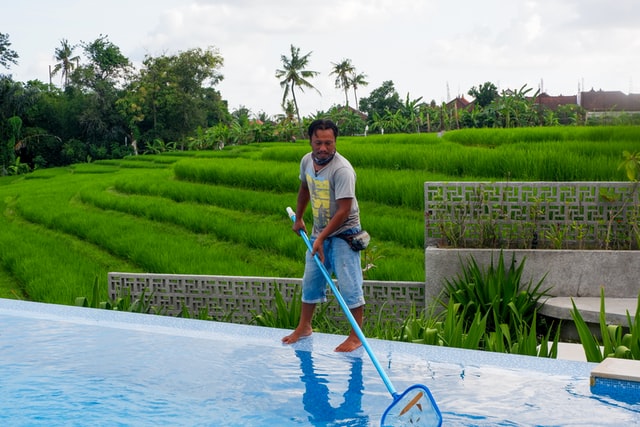How swimming pools are cleaned?
Swimming pools are cleaned by a process called chlorination. Chlorine is used to kill bacteria and other microorganisms that may be in the water.
The first step in chlorination is to mix chlorine with water, usually in a ratio of 1 part chlorine to 19 parts water. The mixture is then poured into the pool and allowed to circulate for 10-20 minutes.
The next step is called shocking, where high levels of chlorine are mixed into the pool at once, killing all bacteria and microorganisms in the water. This process lasts for about 30 minutes before the pool returns to its normal level of chlorine.
How to clean swimming pool water?
The water in a swimming pool can be cleaned with a few simple steps.
First, you need to vacuum the bottom of the pool. This removes the dirt and debris that has settled down there.
Next, you need to clean the sides of the pool with an algae brush and a long-handled scrubber. This will remove any algae that may have grown on the walls of your pool.
Finally, you need to use a leaf net to clean up any leaves and other small debris on top of the water’s surface before they sink down into your pool again and start growing there.
How does our swimming pool stay clean?
There are many ways to keep a pool clean. One of the most common ways is to use a pool filter. The filter removes all the dirt and debris that gets into the water.
The pool filter also removes any chemical residue that can build up in the water. This is important because it can cause damage to the skin and eyes. When this happens, it’s time to replace your filters or clean them with a solution of bleach and water.
How to maintain swimming pool hygiene and safety?
A swimming pool is a public health hazard if not properly maintained. Proper maintenance includes keeping the water clean, disinfecting the pool and its equipment, and preventing access to children or pets.
The first step to maintaining a healthy pool is keeping it clean. Pool owners should skim the surface of their pool with a net or vacuum cleaner at least twice a week to remove dirt and debris from the surface of the water. A filter system should be installed on the pump intake that will filter out any contaminants before they enter your pool’s circulation system. The filter system should be cleaned monthly, and replaced every three months in order to maintain proper filtration levels.

How are swimming pools sanitized?
The most common method of sanitizing a swimming pool is the use of chlorine. When chlorine is added to the water, it reacts with other compounds to produce a variety of disinfectant byproducts. These byproducts are what make the water smell like “chlorine” and they are also what kills microorganisms.
Swimming pools are typically sanitized using chlorine, which reacts with other compounds to produce a variety of disinfectant byproducts that make the water smell like “chlorine” and kill microorganisms.
How to clean a pool professionally?
Clean pools can be a difficult task and if you are not an expert, it is best to leave the job to the professionals.
Pool cleaners are experts in the field of pool maintenance and they use professional equipment to ensure that your pool is clean and safe.
The first step in cleaning a pool is getting rid of any debris which has collected on the surface of the water. This will help to prevent dirt from building up on the walls or floor of your pool.
Cleaning a pool can be time consuming but it doesn’t have to be difficult or expensive. You can hire a professional company who will take care of all aspects of your swimming pool for you at an affordable price.
How to clean swimming pool with vacuum?
A swimming pool needs to be cleaned in a regular basis. There are two ways to clean a swimming pool: with a vacuum or by hand.
In this article, we will focus on the first way. Vacuuming is the most efficient way to clean the pool because it can remove dirt and debris from hard-to-reach places and corners.
If you have a high-powered vacuum cleaner, you can use it for this task. You can also attach an extension hose to your vacuum cleaner so that you can reach all parts of the pool more easily.
However, if you don’t have one or if you don’t want to use it for this purpose, then you should buy a special pool vacuum cleaner instead. In general, these tools are more expensive than the standard vacuum cleaners and they are more difficult to store.
What are swimming pool cleaning chemicals?
Swimming pool cleaning chemicals are substances that help maintain the cleanliness of swimming pools. It is important to note that not all pools require the same levels of cleaning, so some may not use any chemicals at all. Cleaning chemicals can be broken down into two main categories: sanitizers and algaecides.
Algae is a natural component of swimming pools, but when it grows too much it can make the pool look green and cloudy. This may be due to high levels of chlorine or other chemical cleaners in the water, or a lack of proper circulation in the water. Algaecides are used to kill algae so that it does not grow back too quickly and make your pool look dirty again.
Sanitizers are used to kill bacteria in the water, which helps people stay healthy and prevents them from getting sick.
What is the healthiest pool system?
The healthiest pool system is the one that is clean and clear.
Pool systems can be made up of many different parts. The most important part of a pool system is the filter. A filter cleans the water by removing dirt, debris, and other particles from the water before it returns to the pool. The cleaner the water is, the better it will look and smell.





